Argonaut Mix-mount or Tri-mount… as opposed to side-mount
The new side mount configuration has been talked a lot for technical diving and I can see a few situations where it can be beneficial. I am not interested in getting in tight spaces, but I would be interested in getting qualified for tri-mix and renting a couple of tri-mix cylinders when traveling to some specific destination.
For some decompression (extended range) diving, I have used doubles with a center outlet and an alternate outlet for a completely redundant regulator, but I would never travel with my doubles unless I was driving somewhere and then I am not interested in oxygen cleaning my doubles for the rare occasion where I want tri-mix (using partial pressure blending).
So I set this up for some Mix-mount diving, as opposed to side mount diving.
The good news:
The hose routing and plumbing worked great. The regulator performance and usability of the connections worked fantastic. I have actually triple redundancy with this system, three potentially independent air sources.
I used the Argonaut Kraken as a manifold block to share the IP from three different first stages. The back-gas is only an AL30 and I set the IP on the Kraken t 110 PSI. The IP on the two Conshelfs is set at 135 psi. Therefore, as long as the shut-off barrel valves are open on either side mount cylinder, the back-gas will not be touched and it will be an extra gas reserve.
There are quick disconnect with shut-off valves on each of the side mount cylinders regulators. I can isolate all three air sources and each one has an independent regulator.
The not so good news (well maybe not so bad):
This was my first in the water test day so my side cylinders position need some adjustment. They are too far forward and dangling too much. They were somewhat clumsy in this position. I also need to adjust my back harness a bit. It is going to take at least one more dive(or two) to get the kit all dialed in.
Using a drysuit and heavy neoprene gloves makes the entire testing process a lot more clumsy.
The side cylinders that I am using are small (61 cuft at 3300 psi) but they are very heavy. I can shed about 8 pounds of lead by using these cylinders. Out of the water they are almost 30 lb each, plus the back-gas cylinder, regulators, and harness it all adds up.
In all, this is an interesting and versatile setup and I will be experimenting and developing it further, but it will never replace my simple steel 72 (or a rental AL80 in the Caribbean) on my VDH backplate with a simple wing.
Here are some pictures taken by John in Sebago lake.


The front of the tanks are too low. The bottom tank band needs to be close to the center of the cylinders and the valves need to be tucked under my arm.
I will fix that next test dive.





BTW, this was also a working dive. John and I installed a mooring ball. On my right hand is a mesh bag with tools and on my left hand is a lift bag.

The new side mount configuration has been talked a lot for technical diving and I can see a few situations where it can be beneficial. I am not interested in getting in tight spaces, but I would be interested in getting qualified for tri-mix and renting a couple of tri-mix cylinders when traveling to some specific destination.
For some decompression (extended range) diving, I have used doubles with a center outlet and an alternate outlet for a completely redundant regulator, but I would never travel with my doubles unless I was driving somewhere and then I am not interested in oxygen cleaning my doubles for the rare occasion where I want tri-mix (using partial pressure blending).
So I set this up for some Mix-mount diving, as opposed to side mount diving.
The good news:
The hose routing and plumbing worked great. The regulator performance and usability of the connections worked fantastic. I have actually triple redundancy with this system, three potentially independent air sources.
I used the Argonaut Kraken as a manifold block to share the IP from three different first stages. The back-gas is only an AL30 and I set the IP on the Kraken t 110 PSI. The IP on the two Conshelfs is set at 135 psi. Therefore, as long as the shut-off barrel valves are open on either side mount cylinder, the back-gas will not be touched and it will be an extra gas reserve.
There are quick disconnect with shut-off valves on each of the side mount cylinders regulators. I can isolate all three air sources and each one has an independent regulator.
The not so good news (well maybe not so bad):
This was my first in the water test day so my side cylinders position need some adjustment. They are too far forward and dangling too much. They were somewhat clumsy in this position. I also need to adjust my back harness a bit. It is going to take at least one more dive(or two) to get the kit all dialed in.
Using a drysuit and heavy neoprene gloves makes the entire testing process a lot more clumsy.
The side cylinders that I am using are small (61 cuft at 3300 psi) but they are very heavy. I can shed about 8 pounds of lead by using these cylinders. Out of the water they are almost 30 lb each, plus the back-gas cylinder, regulators, and harness it all adds up.
In all, this is an interesting and versatile setup and I will be experimenting and developing it further, but it will never replace my simple steel 72 (or a rental AL80 in the Caribbean) on my VDH backplate with a simple wing.
Here are some pictures taken by John in Sebago lake.
The front of the tanks are too low. The bottom tank band needs to be close to the center of the cylinders and the valves need to be tucked under my arm.
I will fix that next test dive.
BTW, this was also a working dive. John and I installed a mooring ball. On my right hand is a mesh bag with tools and on my left hand is a lift bag.
Attachments
-
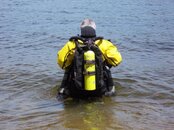 DSCN5395_zpszjfcqomy.jpg82.9 KB · Views: 303
DSCN5395_zpszjfcqomy.jpg82.9 KB · Views: 303 -
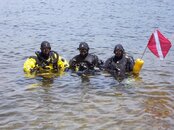 DSCN5398_zpszdpy1wzp.jpg91.8 KB · Views: 292
DSCN5398_zpszdpy1wzp.jpg91.8 KB · Views: 292 -
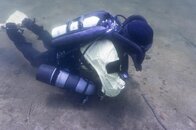 DSC02750_zpshejow4ir.jpg45.9 KB · Views: 327
DSC02750_zpshejow4ir.jpg45.9 KB · Views: 327 -
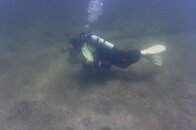 DSC02735_zpsgz7fstjn.jpg23.4 KB · Views: 289
DSC02735_zpsgz7fstjn.jpg23.4 KB · Views: 289 -
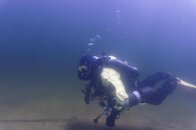 DSC02740_zps9ocb1ou7.jpg21.6 KB · Views: 293
DSC02740_zps9ocb1ou7.jpg21.6 KB · Views: 293 -
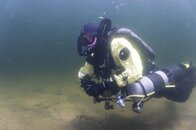 DSC02754_zpsflorjtbt.jpg33.7 KB · Views: 269
DSC02754_zpsflorjtbt.jpg33.7 KB · Views: 269 -
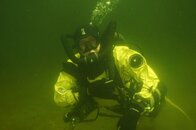 DSC02857_zpsqgzvpznw.jpg26.3 KB · Views: 293
DSC02857_zpsqgzvpznw.jpg26.3 KB · Views: 293 -
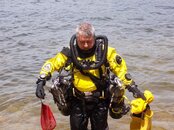 DSCN5433_zps9suxqbs5.jpg91.7 KB · Views: 265
DSCN5433_zps9suxqbs5.jpg91.7 KB · Views: 265
Last edited by a moderator:




